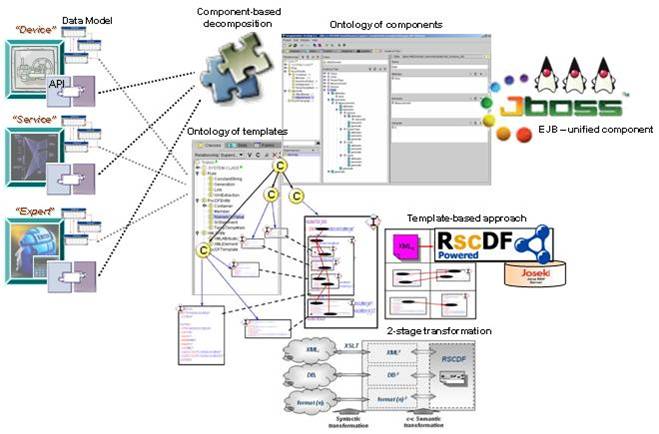|
Deliverable 1.2
General Adaptation Framework: A Framework for Semantic Adaptation of Maintenance Resources

Another obstacle for the Semantic Web standardization effort relates to the fact that despite many
industrial companies and consortiums have realized that explicit description of semantics of data and domain modeling
is necessary for application integration, they have still used for that purpose their company/consortia specific
standards or XML language that is inappropriate for global integration. Even realizing that Semantic Web is providing
really global standards, it is already too late, labor and resource consuming to transform manually huge amount of
already modeled metadata from a local to the global standard. One possible solution could be designing semantic adapters,
which enable semiautomatic transformation from company specific standards to Semantic Web standards. This motivates the
second objective of the SmartResource project (Adaptation Stage, year 2004) - a design of General Adaptation Framework,
which provides a methodology for designing adapters from various data formats to RSCDF and back. In the project the
approach of General Adaptation was tested on concrete implementations - adapters for three different samples of
heterogeneous resources (device data, expert interface, Web-Service).
In the approach of General Adaptation we distinguish two aspects of adaptation: data model transformation
and Application Programming Interface (API) adaptation. The first aspect focuses on a transformation of resource data
stored in a specific data model (relational database, family of XML-based standards, UML, etc.) to a unified semantic-rich
format, in our case to RSCDF, and vice versa. For this purpose, we utilize a method of two-stage transformation,
which assumes mapping of a specific data model to a corresponding canonical form from the same family of data
representation standards. If, for instance, we need to transform an XML schema to RSCDF, first of all we have to define
the XML canonical schema and make a mapping with it. The strength of the two-stage transformation is in reuse of a variety
of existing powerful tools for data model mapping and also in simplification of the data model mapping process for
potential customers - owners of resources that are intended to be integrated into the target maintenance environment.
The owners do not have to think about complicated ways of transformation of their data models to RDF-based standards -
they just have to map their data model to the canonical one within the same standard (e.g., XML). After native-to-canonical
data model mapping, the template-based approach of a transformation from a canonical form to RSCDF is applied according to
GAF. This approach is based on automated generation of XML serialized RSCDF instances, which are determined from the
ontology of templates. The ontology stores classified pairs of correspondence between canonical and RSCDF patterns -
chunks of terminal strings of text. Thus, in fact, thanks to GAF, the process of data model transformation requires two
efforts: mapping between the initial and canonical data schemata, and engineering of the ontology of templates. Having
these two activities done, the data transformation between a native and RSCDF formats is carried out automatically.
The second aspect of adaptation - API adaptation - relates to a possibility of automated access to data
entities in native storages through native application interfaces. For instance, a database entity can be accesses
via ODBC (Open Database Connectivity) connectors using functional calls in different programming languages. To access
a certain database records for further data transformation an appropriate programming component must exist. The
component can either execute native functional calls or perform a direct access to the native data storage. Hence, to
automate the retrieval of native data entities the existing types of API's must be decomposed using component-based
analysis, classified and arranged into a centralized/decentralized library5. Such components, in a vision of GAF, are
building blocks for automated assembly of a concrete adapter on the fly. The automated component integration is performed
using ontology of components and the resulting adapter is run as an EJB (Enterprise Java Bean) component on a JBoss
Application server in our implementation.
To a have a comprehensive framework for adaptation of resources, ontology of templates and ontology of
components must be closely interrelated due to high dependency between data models and methods of accessing the
corresponding data.
|
|
|

